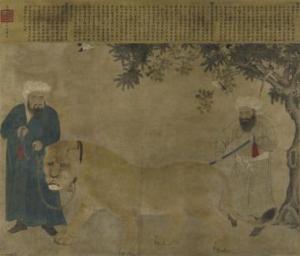Do you like Buddhist sculpture?
You are curious about Asian Art collections gathered by art dealers?
You are interested in Nepalese and Tibetan pieces?
On Sunday October 5, I attended a lecture given by Fabio Rossi, head of the famous Rossi & Rossi art gallery and one of the founding members of Fine Art Asia. The lecture was part of the education program scheduled for the 2014 fair. I read about it in the fair program and thought that could be relevant for my further knowledge on Tibetan Ancient Art. It was also quite complementary to the lecture given by Jane Casey at OCS on Nepalese Paintings.
Fabio Rossi introduced us to his family’s famous collections. That Italian art dealer created a Hong Kong based gallery in 2013 but Rossi and Rossi is a family business first created by Fabio’s mother, in Italy and then in the UK, about 40 years ago. The first interesting characteristic of that Asian Art business relies in the fact that it is run by Italians, usually more focused on Baroque objects or European paintings.
How did they started? In the 1970s, Mme Rossi enjoyed traveling frequently to Asia, India and Himalaya. She was very keen on art coming from Gandhara (Afghanistan), Tibet and Nepal and could spend hours in markets and merchants shops to negotiate pieces. As a young boy, Fabio Rossi would accompany her on her very long trips and learn about Asian Art. The business grew as the collection increased. Publications, catalogs and exhibitions contributed to the credit of The Rossi family which became a milestone on the way for collecting Tibetan art and Mandalas. An Art dealer family was born.
Fabio Rossi described us the many trips he did to Hong Kong and China, Malaysia, Taipei (and its splendid National Palace Museum) when those destinations were still pretty much ignored by the main stream tourists. Around 1990, Fabio joined his mother into the art business and encouraged her to also collect contemporary art from Himalaya, Cambodia, or Tibet. In November 2013, the gallery Rossi & Rossi commissioned Asian artists original pieces to respond to the recent acquisition and exhibition of book covers dating from the 12th c.
The gallery is worldwide famous for its beautiful works depicting Buddha and dating from the eleventh – twelve century, from China, India and Tibet . They provide Museums, such as the Louvre d’Abu Dhabi or the MET, with Asian artifacts. Rossi & Rossi showcases also nice examples of cultural cross over between China and India. The most interesting example would be The Lioness, a Ming ink on paper exhibited in Beijing and also in Hong Kong in 2013, for the opening of the new gallery.
The Lioness
1483 (Chenghua Period, Ming Dynasty) China
Framed ink and colour on paper 242 x 287 cm (95 ¼ x 113 in) picture@Rossi &Rossi
Fabio Rossi also gave us some clues on Buddhist iconography and the ways you could identify pieces.What did I learned? There used to be no human image for Buddha until very late on. Lions or animal figures would rather depict him. In 250 BCE, foot prints in stupa started to appear, representing Buddha or a moment of nirvana. During the first century after CE, the first images of Buddha emerged, influenced by the Hellenist style used for ancient gods and goddesses. The Gandhara region provides amazing examples of that style, such as the following piece, which was sold for a million HKD during the Fair. Then, Buddhist artists traveled all over Asia and developed local iconography influenced by regional styles and standards.
Bodhisattva head, Gandhara, Stucco, 25 cm (10 in) c. 4th-5th Century A.D., picture@Rossi&Rossi
Topics and Keywords:
Solo: Themes and Topics to focus on in that exhibition
Fine Arts, Mandala, Tibet, Nepal, India, Ming, Qing, Decorative Arts, Buddha sculptures, Bronzes.
Combo: On the same topic:
ROSSI & ROSSI
27 Dover Street London W1S 4LZ
T: +44 0207 629 6888 info@rossirossi.com
Under Renovation, OPENING SOON



to be honest, I didn’t know that this family was so active in Hong-Kong. London gallery is closed if I understand, but will be an opportunity for oncoming UK stop